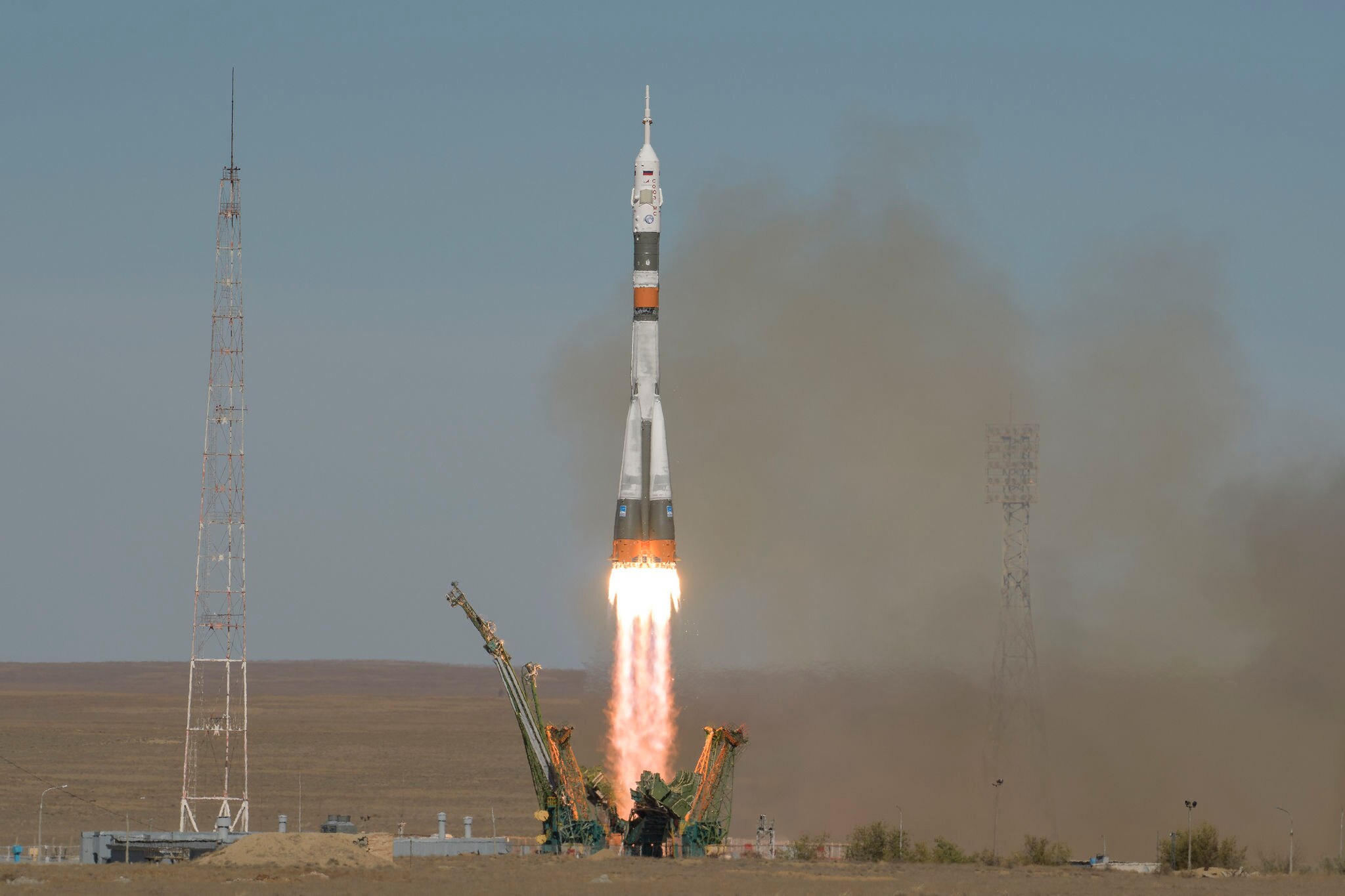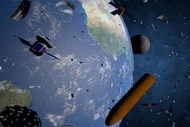Create a free profile to get unlimited access to exclusive videos, sweepstakes, and more!
BREAKING: Soyuz rocket failure after launch forces emergency landing; crew safe on the ground

[Correction: I had originally said the problem occurred at stage separation, but it was after the side boosters separated. I also put up a photo of the side boosters separating indicating it might have shown the problem, but the image is too blurry to tell definitively if there actually was an issue at that moment, so I have replaced it.]
A major failure in a Russian Soyuz rocket forced an emergency landing for an American astronaut and a Russian cosmonaut on their way up to the International Space Station this morning. Both men are safe and reported to be in good condition after a harrowing return to Earth.
The launch was from the Kazakhstan launch facility at 08:40 UTC (4:40 Eastern U.S. time). Everything appeared fine, but two minutes into the flight, when they were approximately 50 km above the ground, there was an as-yet-unknown event that caused the failure. Video of the launch captures the moment (at about 3:40 into the video, which I’ve set to start at 2:30):
The feed switches to inside the capsule, and you can see the sudden shaking as the liquid-fuel side boosters separate. When the feed cuts back to a telephoto camera view from the ground, the side boosters can be clearly seen moving away from the rocket. This was something like six seconds after the escape tower was jettisoned (a solid-fuel rocket on top of the capsule that is designed to pull the capsule away from the rocket extremely rapidly in case of emergency). Everything appears fine, but then at about 3:40 into the video you can hear them say the booster has failed (later you hear them say the failure occurred at 11:42:17 [local time], a little over two minutes into the flight). The crew say they are weightless: In other words on a ballistic trajectory with no powered flight.
To be clear, I am not necessarily connecting any of these events as a cause of the failure. I am just noting the timeline. However, it’s impossible not to notice the timing happened not long after the side booster separation, when a lot of mechanical events are occurring. I’m sure the investigation will focus there.
Momentum carried the capsule up higher, but then it began to fall to the ground in what’s called a “ballistic descent,” an angle steeper than usual. However, after this point everything appeared to work well (though there are reports the men inside underwent higher than normal but still manageable accelerations of 6 to 8 gs). The capsule landed minutes later a few hundred kilometers east of the launch site, and a rescue found them.
The men, NASA astronaut Nick Hague and Russian cosmonaut Alexey Ovchinin, are being transported back to the Gagarin Cosmonaut Training Center in Star City, near Moscow.
An investigation is already underway, and at the moment not much more about the mechanics of this event is known.
Commander Gerst took this dramatic shot of the launch from the ISS itself:
The implications of all this aren’t clear. Right now, the Russian Soyuz rocket is the only way to launch humans to the ISS (and, I’ll note, is generally reliable, though there have been issues in the past). There are currently three people on the station now (ESA astronaut and commander Alexander Gerst, NASA astronaut Serena Auñón-Chancellor, and Russian cosmonaut Sergey Prokopyev). They have enough supplies to last for several months. They’ve been in space since June and were scheduled to return to Earth in mid-December. The next crew launch to ISS after this one was scheduled for December 20. This will almost certainly be delayed as the investigation continues.
The return of the current crew may not be delayed, though: There’s a return capsule docked with ISS, but the fuel it uses has a finite lifetime. I don’t have hard numbers, but I’ve heard it’s good for about six months, meaning they’ll have to come back to Earth sometime around their scheduled return date anyway. The only other option would be to keep them on board and send up an empty return capsule for them on another rocket (this has been done before). However, given this rocket failure, I don’t think that’s a great option. NASA is pretty conservative when it comes to things like this, and I expect they would rather return the crew as scheduled than rely on sending up a capsule on a rocket similar to the one that just failed. I’m guessing, however.
The ISS has been continuously occupied since November 2000, so if the crew returns on time with a delay for the next, this would be the first time the station would be empty for nearly 18 years.
That’s… disappointing. However, of course, nothing is more important than the safety of the crew. Making sure they return to Earth healthy and secure is paramount.
You may wonder if Boeing and/or SpaceX could accelerate their crewed launch capabilities (the first test launches have been pushed back to sometime in 2019). They might, but my gut feeling is that this isn’t a real option; NASA wouldn’t allow shortcuts that could compromise safety (some delays in the crewed missions have been due to safety requirements for launching humans versus uncrewed flights). Remember, at the moment, no lives are really at stake here. The current crew can just come home, leaving the ISS empty until a new crew can be sent.
However, given the situation, it seems likely that until the cause of the rocket failure is known there won’t be more crew launches.
And let me put this out there, since I’m already hearing complaints on social media that had the Shuttle not been canceled, this wouldn’t be as big a problem: I’m not so sure. The Space Shuttle program was getting very old and needed to be replaced with something more updated. It was canceled by President Bush (a lot of people say Obama canceled it, which is simply wrong), and a new program, Constellation, was started up to replace it. However, there were huge cost overruns and delays, and so President Obama canceled that. The Commercial Crew program was started up, but of course delays in that put us where we are now. I can make lots of arguments about the timeline there (and why relying on the Russian space agency alone is a huge problem for many, many reasons), but in the end, developing a new way to take humans into space takes a long time and a lot of money.
We need more systems with more overlap, and hopefully in a few years we’ll be there. But we’re not there yet, and so the ISS may have to orbit without humans on board for the first time in nearly two decades.
As for what happens next, unfortunately all I can say is that we have to wait and see. I recommend following some folks on Twitter for up-to-date info: NASA, the NASA ISS feed, and the always reliable space reporter Eric Berger. You can also keep up with the NASA ISS blog. I’ll also have more info as soon as I hear it (and can be shown it's reliable).
And as always, it's worth remembering: There’s a reason we say per ardua ad astra.
















